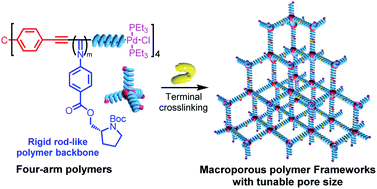Precise fabrication of porous polymer frameworks using rigid polyisocyanides as building blocks: from structural regulation to efficient iodine capture†
Abstract
Porous materials have recently attracted much attention owing to their fascinating structures and broad applications. Moreover, exploring novel porous polymers affording the efficient capture of iodine is of significant interest. In contrast to the reported porous polymers fabricated with small molecular blocks, we herein report the preparation of porous polymer frameworks using rigid polyisocyanides as building blocks. First, tetrahedral four-arm star polyisocyanides with predictable molecular weight and low dispersity were synthesized; the chain-ends of the rigid polyisocyanide blocks were then crosslinked, yielding well-defined porous organic frameworks with a designed pore size and narrow distribution. Polymers of appropriate pore size were observed to efficiently capture radioactive iodine in both aqueous and vapor phases. More than 98% of iodine could be captured within 1 minute from a saturated aqueous solution (capacity of up to 3.2 g g−1), and an adsorption capacity of up to 574 wt% of iodine in vapor was measured within 4 hours. Moreover, the polymers could be recovered and recycled for iodine capture for at least six times, while maintaining high performance.

- This article is part of the themed collections: Most popular 2022 materials and energy articles and Metal organic frameworks and porous polymers


 Please wait while we load your content...
Please wait while we load your content...